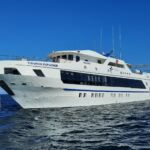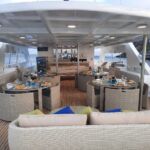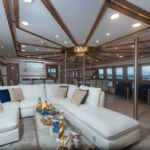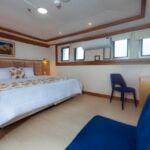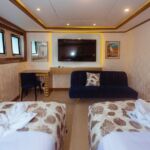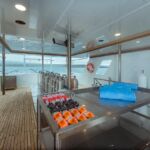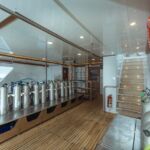Tiburon Explorer
Tiburon Explorer
Enjoy the rich biodiversity and stunning landscape of the Galapagos Islands aboard Tiburon Explorer! This luxury upscale SCUBA diving liveaboard afford all the comforts of home, with all the adventure of scuba diving through a 28,000-square-mile national park preserve.
Debuting in 2020, Tiburon Explorer Galapagos liveaboard accommodates 16 passengers in 9 air-conditioned staterooms. Located on the main and lower decks, each stateroom is climate controlled, include private bath and can be converted to a queen or twin beds.
This contemporary and state-of-the art vessel features a salon on the main deck for lounging and dining, a partially covered sun deck with a jacuzzi and ample space for relaxing, and a large dive deck, with camera table with charging station and storage bins. Diving operations are conducted from two large pangas (tenders), easily boarded from the dive deck.
With an onboard naturalist and a diving instructor assistant on staff, you will experience dive sites like Cape Rosa—arguably the most beautiful of the Galapagos Islands, with rock fissures and sea lions basking in the warm sun. Keep your eyes open for the occasional sea turtle or penguin fluttering by for a quick photo close-up.
No dive trip to the Galapagos is complete without a visit to dive “The Arch”, which is only accessible by liveaboard and showcases an impressive show of schooling pelagic fish, hammerheads, whale sharks and spotted eagle rays. There is no shortage of superior dive sites in the Galapagos—watch penguins at Cape Douglas, colonies of red-footed boobies, blue-footed boobies at Pitt Point.
Galapagos diving liveaboard itineraries are examples only, and will change depending on local regulation, weather and logistics at the Captain’s discretion. Currently, each week the itinerary includes the same islands. The order of the island visits, however, is dictated by the Galapagos National Park and may vary weekly.
Saturday: Baltra (1 Check Out Dive at Punta Carrion)
Guests fly to the Galapagos Islands from Mainland Ecuador, arriving in the late morning. The dive guides will meet the guests at the airport between 11:30 am and 12 pm and escort them to the Galapagos liveaboard, Tiburon Explorer. Guests will board the vessel, have lunch and listen to the briefings. After the briefings, the guests will do a check out dive at Punta Carrion. After dinner the vessel will depart to the next scheduled destination.
Sunday: Baltra North (2 Dives)
6:30 and 9:30 dives
Sightings include rays and schools of fish.
Afternoon North Seymour land visit. Walk the path around North Seymour Island to see the large colonies of Blue Footed Boobies and Frigate Birds. Sighting of Sea Lions and Marine Iguanas are also common.
Depart for Wolf Island (long transit)
Monday: Wolf Island (4 Dives)
6:30, 10:30. 2:00 and 4:30 dives. Possible night dive.
Sightings often include hammerheads, whale shark (in season), eagle rays, sea lions, Galapagos sharks and silky sharks
Tuesday: Darwin Island (4 Dives)
6:30, 10:30, 2:00 and 4:30 dives
Sightings often include hammerheads, whale sharks (in season) eagle rays, Galapagos sharks and silky sharks.
Transit to Wolf Island
Wednesday: Wolf Island (3-4 Dives)
6:30, 10:30, 2:00 and 4:30 dives
Sightings often include hammerheads, whale sharks (in season), eagle rays, Galapagos sharks and silky sharks.
Transit to Cabo Douglas (12 hours)
Thursday: Cabo Douglas (1-2 Dives)
Sightings include marine iguanas.
Transit to Punta Vicente Roca
Punta Vicente Roca (1-2 Dives)
Sightings often include mola mola, turtles and macro life
Transit to Cousins Rock (10 hours)
Friday: Cousins Rock (2 Dives)
6:30 and 9:30 dives
This is a great macro diving with an excellent chance of seeing sea horses, sea lions and eagle rays. Lunch will be served while transiting to Santa Cruz (3 hours). Travel by bus to the Santa Cruz Highlands to visit the giant tortoises in their natural habitat. Transfer to the town of Puerto Ayora. Dinner on your own in Puerto Ayora. Return to the Tiburon Explorer at 8:30pm.
Saturday: Baltra
Depart the vessel by 9 am. Transfer to the airport.
Registry: Pto Baquerizo Moreno, Galapagos Islands
Length overall: 111.5 ft (34 meters)
Beam: 21.3 ft (6.5 meters)
Draft: 8.2 ft (2.5 meters)
Tonnage: 169 ITC
Main engines: Detroit Diesel 6V92, 350 hp
Generators: 2x Perkins 73 kw
Maximum Speed: 10 knots
Fuel Capacity: 5,300 gallons (20,000 liters)
Range: 1,800 nm
Accommodations: 16 passengers in 8 air-conditioned rooms on main and lower decks, all with private bathrooms and showers. All rooms except rooms 3 & 4 (forward below deck) can be converted to either one queen bed or two twin beds. Up to 7 crew and 2 guides in crews’ quarters.
Safety Equipment: Life rafts (2), life rings/strobes, life vests/strobes, emergency position locator, flares, oxygen and first aid equipment
Air Systems:2 electric Bauer compressors with nitrox membrane, producing 32% nitrox, bank storage
Tenders: Rigid hull inflatables (2), used for passenger transport and diver pickup
Accessories: Diving Equipment
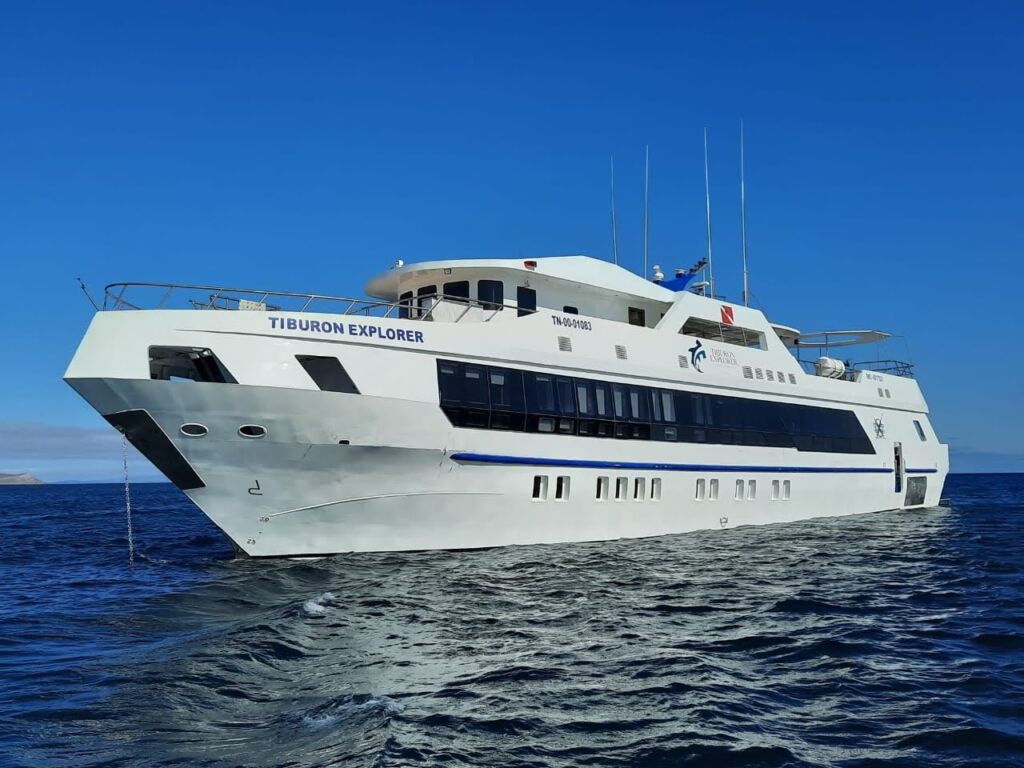
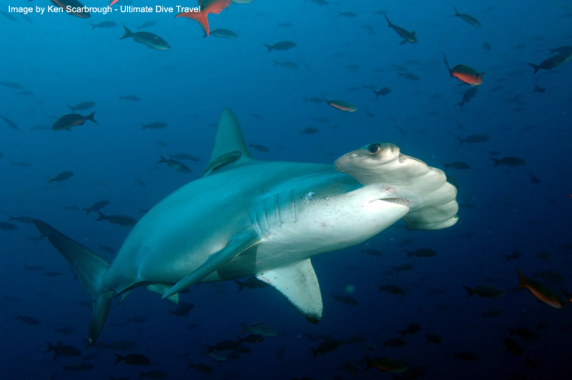
Highlights of Ecuador
While the Galapagos Islands are the main attraction for SCUBA divers, this South American country has much to offer.
Before of after your liveaboard cruise, spend a few days exploring the historic city of Quito, a UNESCO World Heritage site, or travel outside the city limits to the Andean Highlands. Here you can visit Otavalo, known for the indigenous population and bustling artisan market. Travel north and you’ll find Cotacachi, famous for it’s leather goods, giving them the title of “leather capital of the world”. Or unwind in the hot springs at Papallacta, taking in views of the volcanic peaks of Antisana.
Have more than a few extra days to spare? Journey to the Ecuadorian Amazon where you will be immersed in an array of natural wonders and have the opportunity to experience exotic creatures often reserved for your dreams! Jungle lodges will serve as a base to take in the abundance of life and explore everything from the rain forest canopy, jungle floor, the river and sky.
Whether you have a day or a week left to spare. No SCUBA dive vacation is complete without some topside exploration. Ultimate Dive Travel can help arrange all components of your travel, making a complete dive package to suit you needs. Ask a consultant today about trips to the Galapagos Islands and beyond!
FAQ
Most frequent questions and answers
Packages Include:
- 7 nights/8 days aboard the vessel
- 3 meals daily, plus between-dive snacks
- 2-4 dives daily – a total of 18-19 dives
- Use of tanks, weights, and belts
- All domestic alcoholic and non-alcoholic beverages
- Airport transfers between GPS and boat for same-day arrivals and departures
Packages Do Not Include:
- Hotel accommodations
- Flights to/from Galapagos
- Last evening dinner
- Trip cancellation & dive accident insurance
- Premium alcoholic beverages
- Chamber Support Fee: US$35 per person
- Fuel tax: US$150 per person. Fuel tax is included in the retail price as of July 2021.
- Crew gratuities, dive instruction, dive gear rental (other than tanks, weights, and weight belts), Nitrox and retail sales
- Note: entry to the Galapagos Islands also requires a cash payment of US$100 entry fee, as well as the purchase of Tourist Card for US$20 in cash
Galapagos is famous for huge schools of hammerheads, but there is more to Galapagos than just its schooling sharks. You will be diving in a protected and healthy marine environment with an abundance of rare species including Galapagos sharks, whale sharks, mantas, mobulas, eagle rays, stingrays, penguins, orcas, dolphins, mola mola, marine iguanas, turtles, sea lions, butterflyfish, tuna, and pufferfish among many others.
Galapagos has two seasons. High season is regarded as July to November when the Humboldt current is at is maximum force, bringing upwellings of nutrients from the cold depths. This is your best opportunity to dive with whale sharks in Darwin and Wolf. In these months, the water is cooler, visibility is lower, currents can be stronger and the seas can be rough at times. The air temperature is cooler and evenings can be fresh.
The chances of seeing whale sharks are slim during the low season months of December through June. Other popular species, such as the scalloped hammerheads and large schools of fish are present year-round however, making the “low” season desirable if whale sharks are not on your must-see list. Temperatures are warmer and visibility is generally better.
Galapagos is a cold-water destination. Regular temperatures in Darwin and Wolf are 12-14 C (70-74°F) but can be warmer in the early months of the year. Thermoclines can dip to 13C (54° F) in the Western Islands of Punta Vincente Roca and Cabo Douglas, which stay cooler year-round.
The minimum certifiable age for divers is 10 for most SCUBA certification agencies; normally, the agencies restrict 10 and 11-year olds to a maximum depth of 40 feet (12 meters). Children 12-14 years old are restricted to 70 feet (21 meters). Explorer Ventures Fleet therefore allows children as young as 10 years to participate in our trips, with the following restrictions:
- All children under the age of 15 must travel and dive with their parent or guardian, unless undergoing active training with an instructor. Minors must be accompanied onboard by a guardian at all times.
- This itinerary offers no diving opportunities at depths less than 40 feet; diving opportunities for 10 and 11-year olds are not available on this itinerary, and 12-14-year olds will not be able to dive all sites. For this reason, a minimum age of 15 for divers is strongly suggested.
- A parent/legal guardian will be required to sign the liability release on behalf of a child under the age of 18.
To ensure your safety, we require the following of all divers:
- All divers must be certified as open water scuba divers by an internationally recognized certification organization.
- All divers must be experienced divers (we recommend that you have more than 100 logged dives) and have logged at least one dive within the 6 months prior to boarding the vessel. Dives are very often at an advanced level. Currents can be very strong and often divers are required to swim against them.
- All dives are guided by an instructor/naturalist guide and due to Galapagos National Park regulations all divers must dive with the guide at all times.
- All divers must log in and out of the water with a member of the diving staff.
- All divers must have a submersible console. In addition, a timepiece must be worn by at least one diver in a buddy team. Dive computers are required.
- Decompression and solo diving are not allowed under any conditions. The maximum allowed depth is 130’ (110’ on nitrox).
- Diving activities must cease when the consumption of alcohol begins.
- All divers must present proof of dive accident insurance per Galapagos National Park regulations.
- All divers must also carry a DiveAlert, a surface signaling device, and an electronic beacon while diving (all available on board). Guests are responsible for all items they borrow from the vessel.
- Please note that due to a combination of staff and equipment logistics, insurance requirements and local diving regulations, neither rebreathers nor diver propulsion vehicles (DPVs) may be used aboard Explorer Ventures Fleet vessels.
- Please note that flash photography is not permitted while taking photos of wildlife on land. Professional photography and videos recorded for commercial purposes must be authorized by the Galapagos National Park Directorate. Drones are not permitted in the Galapagos.
The vessel provides tanks, weights, and weight belts for your use. If you prefer to rent the rest of your equipment from us, we have all of the equipment that you will need. Please indicate on your application form what equipment (and size) you will require. Otherwise, the following items are the diver’s responsibility:
- Certification Card
- Diving Log Book (strongly encouraged)
- Mask *
- Snorkel
- Fins/Booties *
- Buoyancy Control Device (required) *
- Regulator w/alternate air source, submersible pressure and depth gauges (required)*
- Dive computer (required) *
- Dive light
- Wet suit – 5 mm to 7 mm *
- Hooded vest or hood
- Gloves
- Repair kit w/ spare parts
- Safety flag *
- DiveAlert air horn for regulator *
- Nautilus Lifeline *
* Available for rent on board. Most of our guests bring their own complete set of dive gear. This is the ideal situation; however, due to weight limits or additional travel plans, some of our guests choose to rent gear. We strongly recommend that you bring your own mask, gloves, booties, fins, hood or hooded vest and computer. A personal wetsuit is also a good idea if you have space. Diving in Galapagos can be challenging, and it is important that you are comfortable. Gloves are suggested as the rocks can be sharp and can damage hands
Nitrox is available for an additional charge, as long as the diver is Nitrox Certified.
Packing for a liveaboard trip is much easier than packing for a land-based vacation. The climate doesn’t require much more than shorts, T-shirts, and swimsuits, though at sea the winds can be cold and jackets are often necessary. Sunglasses, a visor/hat, raincoat, lightweight sweater or jacket, long sleeved shirt, backpack, tevas (or similar) are recommended. Soft luggage is also recommended as it takes up very little space when empty.
Guests traveling through Quito who are interested in day tours may wish to bring some items of clothing for slightly cooler temperatures and good walking shoes.
Please remember that the Galapagos Islands straddle the Equator, and the sun can be very strong at times. For this reason, please make sure you have sufficient strength environmentally friendly sunscreen.
In case of rough weather or if you have a tendency towards seasickness, come prepared with motion sickness medications or Transderm patches from your doctor. If you have favorite CD’s or DVD’s, feel free to bring them.
All linens (including sheets, comforters, bath towels, hand towels, dive towels, and wash cloths) are provided on board. If possible, pack your regulator, dive computer, mask, swimsuit, change of clothes, medications and toiletries in your carry-on bag. Having these few items with you will make an unexpected luggage delay far more bearable.
There is a checked luggage limit of one bag up to 50 pounds (23 kilos) for flights between Quito and/or Guayaquil and the Galapagos. An additional fee of up to $50* will be charged for the second bag or overweight luggage. In addition, passengers are allowed a carry-on bag weighing no more than 17.6 pounds (8 kilos) and a personal item. All additional luggage fees must be paid in cash at flight time. (*Prices could change at any time.)
Groups and individuals that book hotel and transfers with Explorer Ventures will be assisted by a representative at the airport for check-in and are less likely to be charged additional fees.
Lunch and evening meals usually consist of salad, potatoes, rice, chicken, beef, pork, and fish. Breakfast is the usual fare of eggs, cereal, toast and fresh fruit. If you have any dietary restrictions or requests, please indicate so on your application form. Please note that specific brands of soft drinks, dressings and foods are often unavailable in the islands, and it can be very difficult for us to find low-fat or soy products and other items common elsewhere. While we will do our best to accommodate your requests, please be realistic and consider bringing some of your own items if the lack thereof may constitute a health risk or seriously compromise the enjoyment of your holiday.
Outgoing calls may be made from the vessel via satellite phone. Please be aware that a charge is assessed for both incoming and outgoing calls.
- Vital messages may be passed to guests by calling the booking office at 1-800-322-3577
- WhatsApp access is available aboard
The local agent can be reached from North America via phone at 011-593-99529-7471, and will be able to contact the vessel. Cellular phone calls and internet access are available when in proximity to some of the islands if your phone is so equipped. Internet cards/access and cellular phone cards are available for purchase at the airport. The connections are based on 3G network and are good for basic emails but not fast enough for large downloads. The vessel’s location does determine the reliability of access to the internet.
The U.S. dollar is the official currency of Ecuador; therefore, it is not necessary to purchase currency before arriving. Most major credit cards are accepted widely when shopping ashore, however, additional fees are charged in Ecuador for their use.
Though all meals, most beverages, transportation within the Galapagos, and much more is included in your trip payment, there are additional items which you may charge to your on-board bill. These include retail items (shirts, etc.), scuba instruction, rentals, nitrox, premium alcoholic beverages, incoming and outgoing telephone calls, and crew gratuities. Other required fees include:
- Chamber Support Fee: $35 per person
- Upon entry to the Galapagos Islands: Per person cash payments of $100 Galapagos National Park fee and $20 Tourist Card.
- Fuel tax: $150* per person. (*Fuel tax is included in the retail price as of July 2021.)
Bills will be settled onboard on Sunday morning. Accumulated charges may be paid using cash, Visa, or MasterCard. American Express, travelers checks and personal checks are not accepted on board, and we are unable to advance cash on credit card charges. (Travelers checks are not accepted in Ecuador nor can they easily be changed into cash.) Credit cards are subject to the 12% VAT plus 5% in bank fees. These charges can be avoided by using cash for onboard charges. ATM machines are available in Quito, Guayaquil, Puerto Ayora and San Cristobal.
Crew gratuities are not included in your package. The crew works very hard, 7 days a week and many weeks at a stretch to provide the best possible service for our guests. The industry standard for crew gratuities on dive trips is between 10% and 15% of the regular package price per passenger (if, of course, you are happy with the service which you have received). Your generosity is greatly appreciated!
First a note about having a current Passport: Passports with a minimum of 6 months remaining before the expiration date are required for all arriving foreign nationals. If in doubt about visas, contact the Ecuadorian Consulate for specific requirements from your country. Transfers between airport (San Cristobal/SCY) and vessel for same day arrivals & departures are included. Retrieving lost luggage after the vessel departs on charter is impossible. It can be retrieved when the vessel returns to port at the end of the charter. The vessel arrives at its final destination port on Monday morning. The Sunday evening meal is on the island and is not included in the price of the trip. Transportation is organized and included for transfer to the airport. The departure tax from Quito and Guayaquil is now included in international flight prices. Please note: Flight times, prices and the Galapagos airport of arrival are all subject to change with little or no notification, and flights often run late. We strongly encourage our guests to plan on arriving at least one and preferably two days prior to your flight to the Galapagos Islands, to ensure that your luggage is with you or to make up for any travel delays. We also recommend that guests plan on an extra night in Quito or Guayaquil before departing Ecuador. The earliest time a guest can reliably expect to connect to another flight is 5 pm on the last Saturday of the trip from Guayaquil or 7 pm from Quito. Ticket holders are required to check-in a minimum of three hours prior to flight time for all international departures, even when connecting from an Aerogal or Tame flight. If you are booking your own domestic flights, the Humboldt Explorer departs from San Cristobal (SCY), not Baltra (GPS). Passengers flying into Baltra must arrange their own transportation to San Cristobal. If you are booking your own domestic flights, the Tiburon Explorer departs from Baltra (GPS), not San Cristobal (SCY). Passengers flying into San Cristobal must arrange their own transportation to Baltra.




